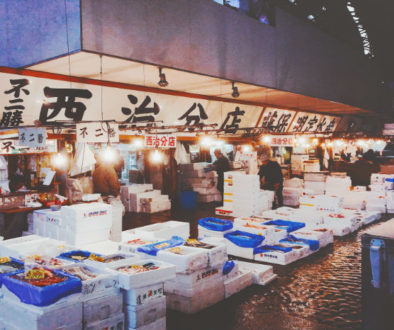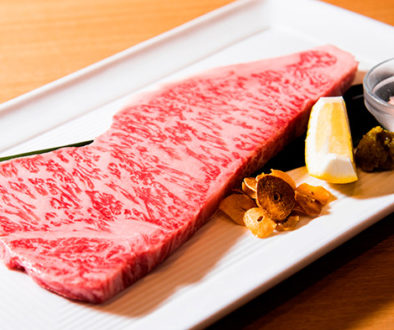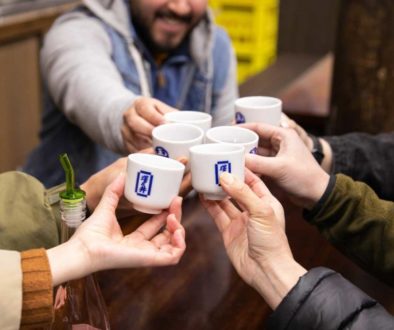Nihonbashi literally means “Japan’s Bridge,” and it is truly the heart of Tokyo. The rise of Nihonbashi started during the Edo Period (1603-1868), when Tokyo was still called Edo. The essence of this period is still alive here today. Let’s explore Nihonbashi by looking at its history, the landmarks, what to do and, of course, its best bites.
History
The Edo Period is when the Shogun Tokugawa, Japan’s ruler at the time, established his power in Edo (what we now call Tokyo). He built the Nihonbashi Bridge in 1603 to be the starting point of the Gokaido, the five major routes connecting Edo to the outer provinces of Japan. As a result, Nihonbashi turned into a vibrant area of commerce, as well as a lively entertainment district. A fish market was also established on the Nihonbashi Bridge. It is even said that sushi was invented here! Nihonbashi became what we call a shitamachi, a lively area full of commerce, shops, and people.
Even today, you can see and visit a lot of historical shops, some of which have been here for 300 or 400 years, for example! On the bridge itself, there is a Kilometer Zero marker as a symbol to mark the starting point of the ancient routes.
Landmarks
Nihonbashi Bridge – Zero Km Marker
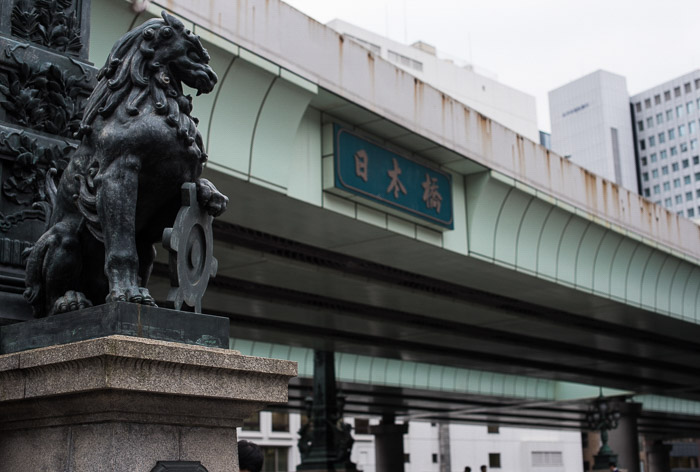
The first thing you have to do in Nihonbashi is to visit the famous bridge. The bridge has a unique design, and lion statues are scattered around to protect the bridge. Test yourself: there are 32 lions on the bridge, can you spot them all?
The Kilometer Zero sign, or Dōro Genpyō, is right in the middle of the bridge. But don’t worry, on one side of the bridge there is a replica, so you can take a picture more easily.
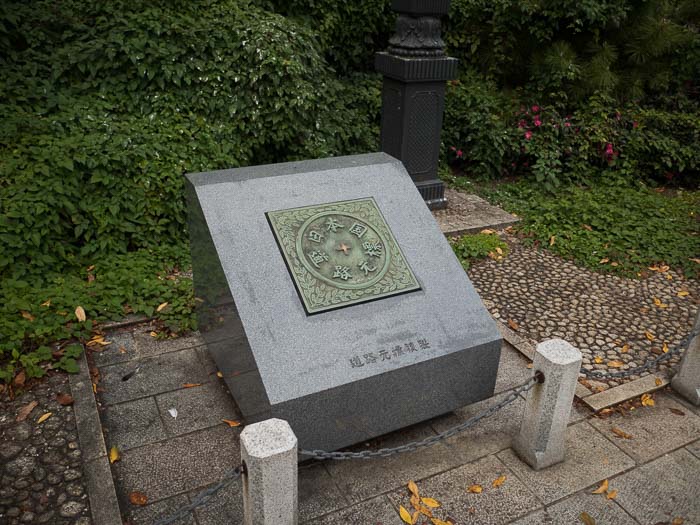
Tokyo’s first fish market was established here before moving to Tsukiji in the 20th century. The Nihonbashi bridge was originally the center of commerce, but because Mount Fuji is visible from the bridge it subsequently became the main focal point of Nihonbashi, as well as a major attraction for centuries to come. Unfortunately, a highway was built over the bridge for the Olympic Games in 1964, so the image of the area has changed drastically. Apparently, the highway will be removed and put underground after the Olympic Games in 2020, so we are waiting for the Nihonbashi area to shine again!
Mitsukoshi
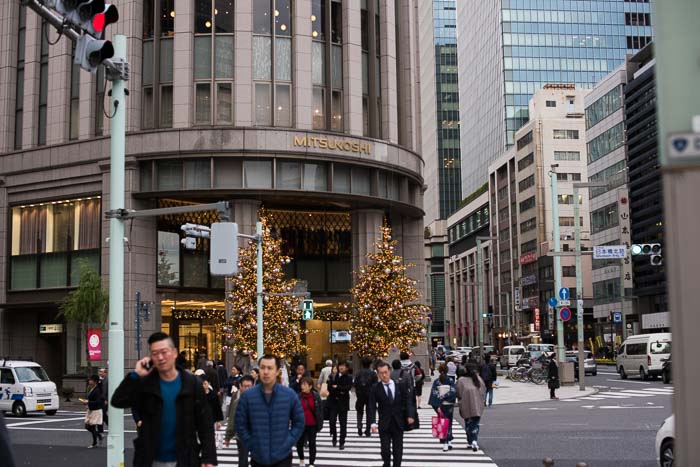
Originally opened as a kimono shop during the Edo Period, Mitsukoshi is Japan’s first department store. The two big lion statues at the main entrance were created based on the lion statues in Trafalgar Square in London, and they are often used as a meeting point.
Inside Mitsukoshi, you can find a number of famous brands, restaurants, and amazing kimono shops. Moreover, it is home to one of the biggest food courts in Tokyo (better to come hungry–there is such a variety of delicious food you might think you are in paradise!).
Fukutoku Jinja
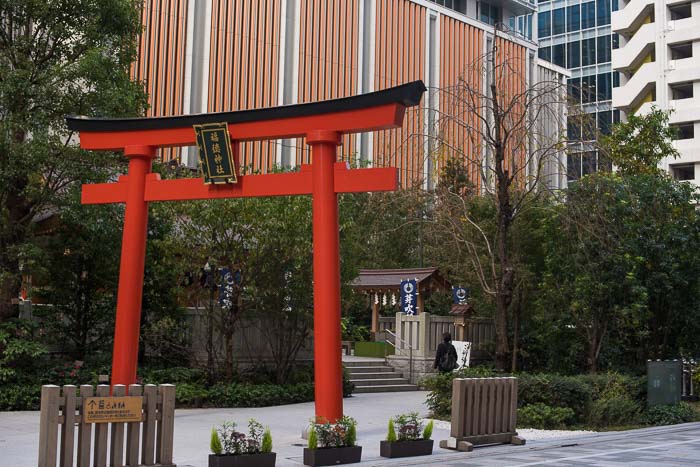
The Fukutoku Jinja, or Fukutoku Shrine, was built here more than 1,000 years ago, when the area was still a small village. It was moved a few times, and then was subsequently rebuilt and opened to the public in 2014 behind the COREDO Muromachi department store complex. The street that leads to the Fukutoku shrine, called Naka Dori, runs between COREDO Muromachi 1 and 2, and it was built to represent how Tokyo looked in the Edo Period. The paved road, the lanterns on the side of the buildings, and the shops that open to the street with their small curtains at the entrance, are all reminders of the past.
The Fukutoku Shrine is said to be lucky with lotteries and for travel. So as a result, a lot of travellers stop here to pray for their safe journey.
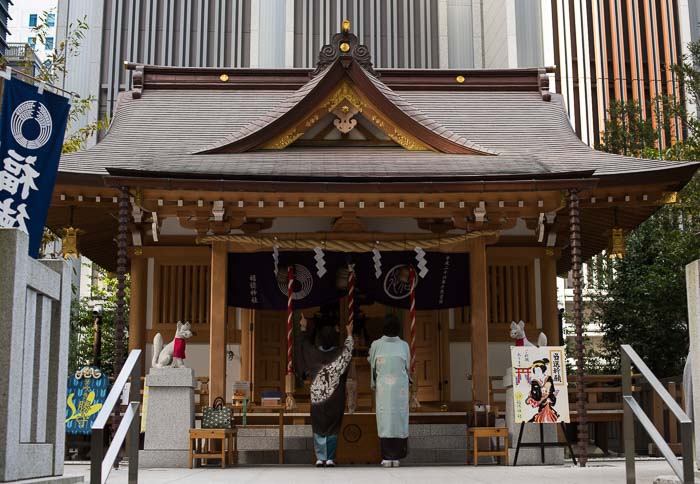
Bank of Japan
The central bank of Japan was established in Nihonbashi in 1882. Before the opening of the Bank and the reorganization of the currency system, each Japanese feudal fief issued its own money. Moreover, right across the Bank of Japan, the Currency Museum was opened in 1982 to show the history of the Japanese yen. The entrance for the museum is free of charge, and inside you can see interesting historical coins.
Kidai Shoran
The Kidai Shoran is a picture scroll that shows Nihonbashi during the Edo Period. The scroll is located inside the Mitsukoshimae station, at the basement of the Mitsukoshi department store, and it is 17 meters long (it is quite hard to miss)! The scroll represents the area from the Nihonbashi Bridge to Kanda station (one station away from Nihonbashi). The original Kidai Shoran was painted in 1805 by an unknown artist. The scroll in the station, however, is only a copy. The original scroll is in the Museum of Asian Art in Berlin.
What to do in Nihonbashi
Tokyo Stock Exchange
The Tokyo Stock Exchange is located just a few minutes away from the Nihonbashi Bridge. Here you can see the gallery and learn about the history of the trading center. You can also participate in a simulated trading game! The Tokyo Stock Exchange is open to the public on trading days.
Mutsui Memorial Museum
The museum was opened in 2005 by the Mitsui family. It has a very elegant atmosphere. Here you can admire the art collection of the Mitsui family. You can also often see temporary exhibitions, usually about traditional Japanese art. Check the website for the latest news: http://www.mitsui-museum.jp/english/english.html
The museum is on the 7th floor of the Mitsui Tower. In the Mitsui Tower you can also find Sembikiya, Japan’s oldest fruit parlor, where you can taste the best parfait in town, as well as the Mandarin Oriental Hotel.
COREDO Muromachi
COREDO Muromachi is a shopping complex (includes COREDO Muromachi 1, 2 and 3) located across the street from Mitsukoshi.
The three buildings of the complex are relatively new and very modern on the outside. However, the inside of the buildings are very traditional, and each floor of each building has a different Edo-style decor. Inside COREDO Muromachi there are specialty shops from all over Japan, historical shops from the Nihonbashi area, and amazing restaurants where you can try traditional Japanese delicacies.
Stroll around Nihonbashi and visit the historical shops
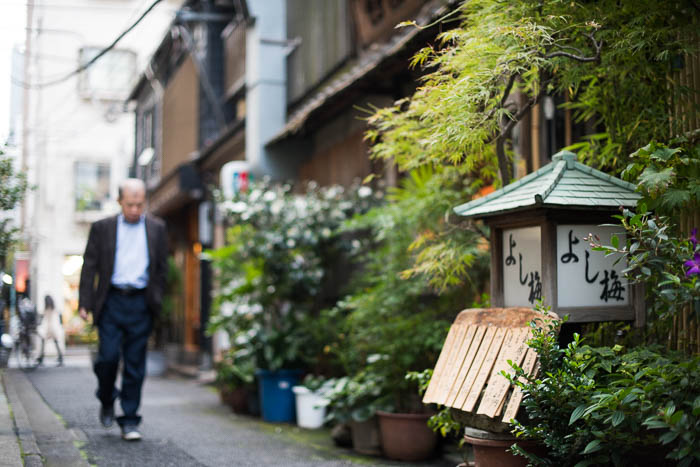
Chuo Dori, or Chuo Street, is the main street of Nihonbashi. Along this street you can find the entrances to the main department stores, such as Mitsukoshi, COREDO Muromachi, and historical shops. Take a step further and visit the area behind the Chuo Dori as well, between the Nihonbashi River and the COREDO Muromachi complex. Here, the streets are smaller and there aren’t any modern buildings. Lose yourself in the little streets and explore the area! You can see plenty of kimono, fans, washi (Japanese paper), lacquerware, and more, as well. Some of the shops here are more than 300 years old!
Visit Ningyocho and collect stamps from the 7 Lucky Gods
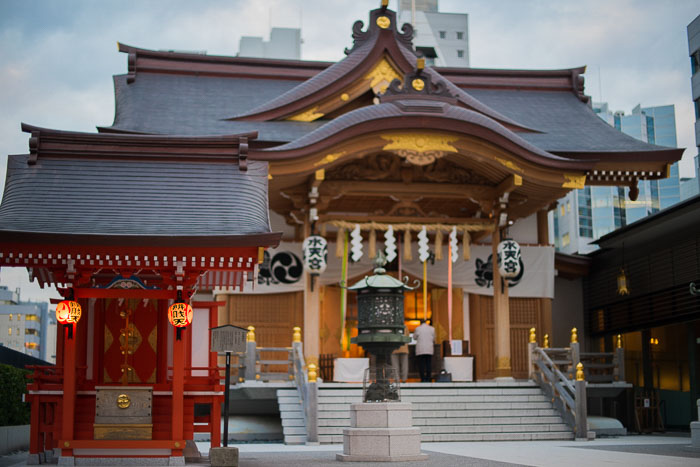
If Nihonbashi is the heart of Tokyo, Ningyocho is the heart of Nihonbashi. It is a quiet area located 10 minutes away from the bridge, full of cute little shops and restaurants with a rich history. In Ningyocho, there are 8 shrines dedicated to the 7 Lucky Gods of Shintoism (one shrine for each god, but 2 shrines are dedicated to the same god). By walking around the area, you can visit the shrines and collect a stamp at each stop. A lot of Japanese people collect these stamps for good luck. It is also the best excuse to explore the area! It takes approximately 2 hours to collect all the stamps.
To build up your energy while you walk around, try some delicious ningyoyaki at Shigemori-Eishindo. Located next to the Suitengu Shrine, the biggest shrine in the area, Shigemori-Eishindo is a small confectionary shop opened in 1948. Ningyoyaki is a Japanese sweet made with a soft batter outside and filled with red bean paste or other flavors.
Cruises
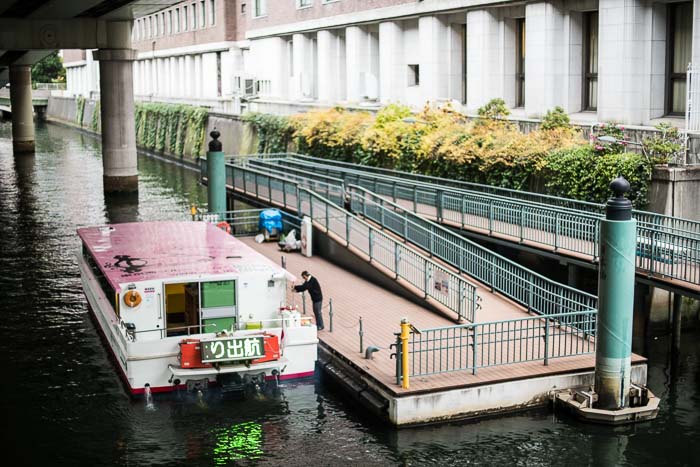
Explore Nihonbashi from a different perspective! Get on a cruise and you’ll get the chance to take great pictures from the boat. There are several companies and several routes you can choose from, and they run almost every day (although the schedule may be affected by the weather). One of the best options is to start from Nihonbashi, go all the way to Odaiba, towards the Tokyo Bay, to admire the Rainbow Bridge, and back to Nihonbashi.
What to eat in Nihonbashi
Tempura
Kaneko Hannosuke ($-$$)
At Kaneko Hannosuke, order the EdoMae Tendon. For 950 JPY, you will get a huge bowl of rice with assorted tempura on top. It is one of the best tempura you will have in Tokyo, and the chef will prepare it right in front of you! But get ready to stand in line, as it is popular among the locals as well.
Address: : 1 Chome-11-15 Nihonbashimuromachi, Chūō
If it is too crowded, don’t worry. They have a second location inside COREDO Muromachi 2 B1. Here, the tendon is smaller (a regular size), and on each table there is a variety of toppings you can add for free, like pickles, seaweed, boiled eggs, etc.
Sushi
Mantenzushi ($$-$$$)
Mantenzushi is located inside the COREDO Muromachi 2, right in front of the Fukutoku Shrine. The simple decor of the restaurant complements the refinement of the sushi. Get the omakase course, where the chef decides your order, and get ready for a tasty journey!
Address: 2 Chome-3-1 Nihonbashimuromachi, Chūō
Soba
Yabukyu ($$-$$$)
Nihonbashi has several good soba places, but Yabukyu stands out. The decor of the restaurant is really traditional, and they use only the best ingredients. Try their curry soba, it is amazing! The soba noodles are freshly made and the curry has a nice and exquisite flavor.
Address: 2 Chome-1-19 Nihonbashi, Chūō
Sukiyaki & Shabu Shabu
Imahan ($$-$$$)
Imahan is located in Ningyocho, really close to the station. Here they use only seasonal ingredients and specially selected products. Their specialties are sukiyaki and shabu shabu, two kinds of hot pot dishes. For the sukiyaki, vegetables and beef are cooked together in the hot pot with soy sauce, mirin (a Japanese sweet seasoning), and other fresh ingredients. Once the meat is ready, you can use a raw egg as a dipping sauce for the meat. Similarly, Shabu Shabu is another kind of hot pot, but here the meat is sliced very thin, so you dip it in the hot pot for few seconds before enjoying it. Shabu shabu is an onomatopoeia, as it is the sound that the meat makes once you dip it in the hot pot.
Try these delicious dishes at Imahan in a very traditional atmosphere. Above all, dine on the second floor, where they have a nice tatami room for you to relax and enjoy your dining experience.
Address: 2 Chome-9-12 Nihonbashiningyocho, Chūō
Izakaya at night
Honen Manpuku ($$-$$$)
Honen Manpuku is a very famous izakaya, or gastro-pub, in the Nihonbashi area. It is located along the river so you can enjoy their exquisite dishes and drinks while getting a beautiful view of the Nihonbashi River. They have a nice variety of dishes to satisfy everyone’s taste, as well as a large drink menu. If the weather is good, dine at the terrace, where you can appreciate the view of the river and the bridge at its best during your meal.
Address: 1 Chome-8-6 Nihonbashimuromachi, Chūō
Sweets
Eitaro Sohonpo ($-$$)
founded in 1818, this confectionery shop is located next to the bridge. They have a nice variety of Japanese sweets, and they are famous for their anko, or red bean paste. They make their own anko paste, which is not too sweet, so it can suit anyone’s taste. Once you enter the shop, you will fall in love with their sweets. The attention to detail in the shape of each dessert is peerless, and the taste is even better. So buy some to give as a souvenir, or enjoy the sweets right in the shop. In addition, there is a cafe area for you to relax and take your time in while exploring the city.
Address: 1 Chome-2-5 Nihonbashi, Chūō
Explore the heart of Tokyo and discover the beauty of the traditional side of this immense city.
Take your time in Nihonbashi, where history fuses with modernity.

